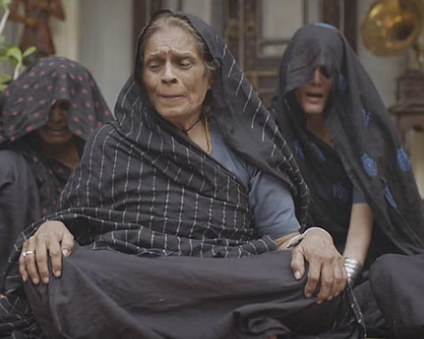India’s culture is so colorful that no country can ever match up to its richness in traditions. Among this colorful myriad of colors is a Rajasthani community, who are almost always peculiarly dressed in black. The Rudaalis are one of India’s most unique communities, and are one of the key elements of the mourning period in traditional Rajput families. While women of the deceased’s family are sequestered into their homes, the Rudaalis howl and weep amidst the gathering in the open. Despite being labeled as inauspicious and damned, the presence of these women is always necessitated in such events in the arid heartlands of Rajasthan.
An ostracized community which became an essential part of Rajasthani funerals
The Rudaalis can be considered amongst some of the luckiest female infants born in rural Rajasthan. These parts are deeply rooted in age-old religious views that are easily considered problematic in their urban counterparts. Illegitimate female children are often almost done away with as soon as they are born. Rudaali communities vary in their norms across these areas. While most of these women are widows, Nidhi Dagar Kundalia writes in her book, ‘The Lost Generations,’ that some are also female servants that work at the houses of ‘thakurs’.
Because of their widowhood, Rudaalis are put on the lowest rung of societal hierarchy, and are treated inferiorly. They, like most Rajput women, are instructed to stay home. Traditionally, their dwellings are also meant to be on the outskirts of the village, withdrawn from society completely. Widows are regarded to have no value whatsoever, since the husband no longer exists. However, becoming a Rudaali gives them some distinct identity, no matter how pitiful.
When an influential man in the village dies, the family hires Rudaalis to come and mourn the death. This kind of mourning translates in Hindi to ‘maatam,’ which is a loud show of grief. Rudaalis beat the ground, their chests, and weep in loud voices. People in these areas are of the opinion that a more exaggerated mourning is a signifier of their higher ranking in the society. Rudaalis therefore, do not hold back on the chest-beating and weeping. They sing songs too, and move very vigorously along with their chants.
As India hurtles towards modernity, Rudaalis are looking for other sources of income
Kundalia writes that some of these women have access to shelter and food, and to influential families as a Rudaali. She speaks to a male servant of one such influential person, who says that the Rudaalis who live with the family are “better off” than those in other communities, who are left to “fend for themselves.” The Rudaali tradition was much more prevalent in the past, when Rajasthan was inundated with royalty and feudal lords. As India shifted to a republic and continues onwards in modernity, cultural practices are left behind. Naturally, Rudaalis have become a mystical topic for the larger audience, which does not hold culture in high regards.
Survival has become difficult for this ancient community, who have resorted to other means of sustenance like animal husbandry. Village communities too are working hard to better their lives via education and finding jobs in towns and cities. They are also putting such practices behind them, as they adapt to a more simpler way of life. Rudaalis have also resorted to farming and daily wage work to support themselves in these times.
The Rudaali community is close to being wiped off from the face of modern history. No matter how backward and stigmatized, Rudaalis were able to survive because of their special profession. As the government seeks a revitalization of India’s rich cultural history, it should make more measures for the welfare of such communities who were abandoned in the pursuit of development.




